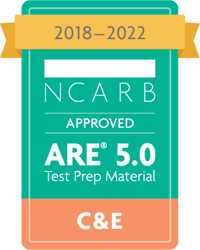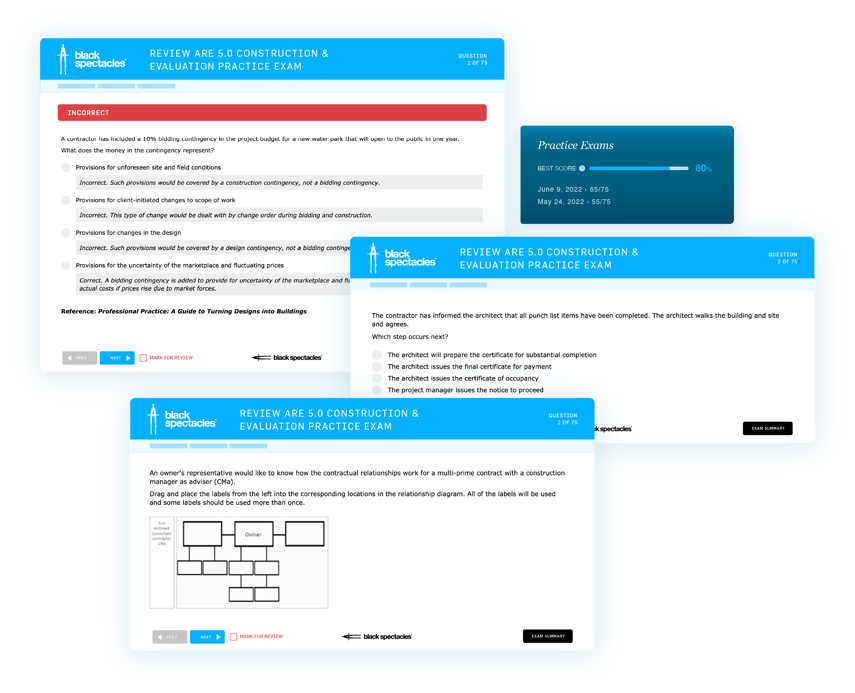Section 1: Preconstruction Activities
Preconstruction refers to the period of time after you wrap up the construction documents phase and before you start construction. This is when bidding occurs, when the design might need to be adjusted to meet the owner's budget, and when a preconstruction conference happens. Preconstruction is also when you set the tone and expectations for the construction phase. All project team members—as well as the owner, architect, contractor, and consultants—should clearly understand their roles and responsibilities, as well as what communication channels should be used.
3 content areas to prepare for the preconstruction section:
1. Interpret the architect’s roles and responsibilities during preconstruction based on delivery method
There are some important tasks you'll have to complete during the bidding phase in order to set the project up for success. You'll need a solid understanding of how to compile a set of bidding documents and how to prequalify bidders. You’ll also need to think about how this phase of the project differs based on delivery method. Your responsibilities for a competitively bid design bid build, or DBB, project will differ from those on a project using a construction manager as constructor, or CMC.
2. Analyze criteria for selecting contractors
As an agent to the owner, you’ll often be asked to make a recommendation about which contractor you think is the best fit for the project. This should be an objective recommendation based on facts, such as their responsiveness to the bidding documents, their price, and their history of successfully completing similar projects.
3. Analyze aspects of the contract or design to adjust project costs
As tough as it may be, the preconstruction phase is often a time when the design must be altered to be more aligned with the owner’s budget. It’s important to do this tactfully so you can maintain the design intent of the project. You’ll need to be able to make recommendations about value engineering opportunities so that the project can move forward.
Section 2: Construction Observation
Unlike other phases of a project, the construction observation phase includes a lot of time spent away from your desk and at the construction site. You’ll need to perform a number of specific duties that are outlined in the AIA B101, such as evaluating the work for conformance with the contract documents and observing the work so you can accurately certify applications for payment. While doing this, you’ll always need to keep in mind the line between your role and the contractor’s means and methods, as well as what your standard of care says about how you should conduct yourself on site.
3 content areas to prepare for the construction observation section:
1. Evaluate the architect’s role during construction activities
It’s impossible to be an architect during the construction observation phase of a project without a thorough understanding of your role on the project. As you prepare for this section of the CE exam, you'll run through scenarios that require you to consider the extent of an architect’s authority on a construction project, what constitutes the contractor’s means and methods, and how to address potential safety or hazardous materials issues on site.
2. Evaluate construction conformance with contract documents, codes, regulations, and sustainability requirements
Comparing the contractor’s completed work to your design intent is one of the most important construction observation activities an architect performs. As an agent to the owner, it’s up to you to determine if the contractor is building the project according to their contract with the owner. In doing so, you’ll need to keep in mind why you made certain decisions during design, and if they’ve been affected by changes in the field. Here, watch for things like code implications, sustainability considerations, and accessibility issues.
3. Determine construction progress
Owners are primarily concerned with quality, schedule, and cost. Objective 2.2 covers how you can help the owner achieve the quality they’re looking for, and in objective 2.3, you’ll be tasked with evaluating if the schedule and cost of the project are in line with the owner’s expectations. While you’re not directly responsible for these things, you need to certify applications for payment and consider the project schedule, so that you can advise the owner if it’s in jeopardy.
Section 3: Administrative Procedures & Protocols
Even if you know how to perform all of your duties during the construction phase, if you don’t properly document everything, you’re setting the project up for communication failures and potential disputes down the road. Section 3 is all about documentation: supplementing your contract documents as necessary, evaluating submittals and RFIs, documenting non-conforming work, and reviewing applications for payment.
4 content areas to prepare for administrative procedures & protocols:
1. Determine appropriate additional information to supplement contract documents
Chances are that every project is going to require supplemental contract documents after construction begins. Unforeseen conditions occur, products become discontinued, or the owner could change their mind about an aspect of the design. Properly documenting these situations and responding to contractor RFIs keeps the communication channels on a project clear.
2. Evaluate submittals including shop drawings, samples, mock-ups, product data, and test results
It’s important to remember that architectural drawings convey design intent, whereas submittals show exactly what the contractor intends to build based on that intent. You’re tasked with comparing the two when you review submittals, and communicating your thoughts graphically or in writing to the contractor helps keep the project moving smoothly.
3. Evaluate the contractor’s application for payment
In section 2, you learned about how to observe the work and document your observations in field reports so that you can evaluate the project’s progress. Now is the time to use that documentation. You’ll need to compare how much the contractor is asking to be paid with how much work is completed in the field. You’ll do that using the AIA G702 and G703, comparing the contractor’s schedule of values to your observations.
4. Evaluate responses to non-conformance with contract documents
Non-conforming work is going to happen during the course of construction. How you address it as a project team is important to maintaining a positive working relationship with your stakeholders—while still ensuring that the project meets applicable codes and construction standards.
Section 4: Project Closeout & Evaluation
Project closeout & evaluation is the smallest section of the CE division, but that doesn't mean you should overlook it. Closing out a project with proper documentation includes evaluating the work at substantial completion, reviewing the punch list, and determining if final completion has occurred.
2 content areas to prepare for project closeout & evaluation:
1. Apply procedural concepts to complete close-out activities
Substantial completion inspections start the warranty period and signify that the project is ready for occupancy by the owner. You’ll need to evaluate the punch list to make sure that the items contained on it are acceptable, and you’ll need to determine if they were completed at the final completion inspection to fully close out the project.
2. Evaluate building design and performance
Looking back at past projects is helpful in informing future decisions. Conducting post-occupancy evaluations is one way to do this, as well as simply meeting with the client a year or so after the project is complete in order to gauge the success of the project. These activities are a great opportunity to talk about potential new projects as well.



